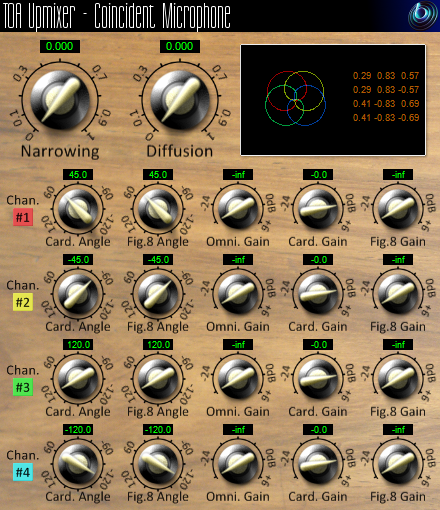New - TOA Upmixer for Coincident Microphones
Posted: 9 July 2014
Version 1.1.3 of the TOA Upmixers library adds two new plugins, one of which is the "TOA Upmixer - Coincident Microphone" plugin.
This plugin is designed for use with all-in-one 2D "surround microphones" like the Zoom H2 or Milab SRND 360, or Double M/S systems. It can be set up for other similar systems too, if the microphone response is formed from close-spaced simple capsules (i.e. omni, figure-of-eight or cardioid) or combinations. It needs three or four well-spaced channels, so stereo microphones won't work - you'll probably want to use the "TOA Upmixer - Stereo" plugin instead.

It works by observing that the simple capsule responses in these microphones have a direct relationship with the components of plain old first order ambisonics (well, just the 2D W X Y channels - there's no height) and finds a mixing matrix (shown) to do the conversion. This horizontal-only first order ambisonics can then be tidied up using the same narrowing and diffusion controls that are available in the TOA First Order Injector plugin. Alternatively, you can get sharper imaging using the TOA Harpex plugin if you have it.
This means that you can introduce 2D surround recordings from these coincident systems into TOA streams in a natural way, without damaging the original spatial imaging.
Don't expect miracles! There are only three ambisonic channels here, and TOA normally uses sixteen - there's a lot of spatial detail missing and imaging is very blurred when compared to proper TOA panning. TOA Harpex can help, but only so much. Further, more economically priced microphones may have capsules that are less precisely matched or calibrated than they would be in a proper first order ambisonic microphone. However, this plugin does provide an easy and natural way to convert surround field recordings to TOA for manipulation and mixing with sharper material. And it's great for diffuse ambient "backgrounds" where precise localisation is less important.
To avoid confusion, we should also mention the rather exciting Brahma microphone project, which physically modifies Zoom H2 or H2n microphones so they are designed to produce proper 3D first order ambisonics. This plugin will not work with them - it is designed to work with unmodified microphones. If you are lucky enough to have a Brahma microphone, you don't need this plugin and you should just convert from A to B format and then use the TOA First Order Injector or TOA Harpex if needed.
